Sino-InSpace: A Digital Simulation Platform for Virtual Space Environments
Abstract
1. Introduction
2. Platform Orientation and Data Source Analysis
3. Key Technologies
3.1. Time-Space Datum
3.2. Environment Data Organization
3.2.1. Organization of Geographical Environment Data
3.2.2. Discrete Space Environment Data Index
3.3. Entity Object Model Design
3.4. Visualization Scenario Organization
3.5. Visualization Engine Design
4. Design of Platform Application Modes and Case Study
4.1. Application Directly
4.1.1. Application Main Window
4.1.2. Visualization and Deduction
4.1.3. Virtual Reality Setup
4.2. Visualization Development
4.3. Scientific Analysis
5. Platform Evaluation
5.1. Hypotheses
5.2. Participants and Procedure
5.3. Evaluation Result
6. Discussion
Supplementary Materials
Author Contributions
Funding
Acknowledgments
Conflicts of Interest
Appendix A
Usability
| Almost Never | Some of the Time | About half of the Time | Most of the Time | Almost Always |
| 1 | 2 | 3 | 4 | 5 |
User Acceptance
| Extremely Unlikely | Quite Unlikely | Slightly Unlikely | Neither | Slightly Likely | Quite Likely | Extremely Likely |
| 1 | 2 | 3 | 4 | 5 | 6 | 7 |
Presence
| Strongly Disagree | Disagree | Neutral | Agree | Strongly Agree |
| 1 | 2 | 3 | 4 | 5 |
Appendix B
Software Design
| Not at all | 1 | 2 | 3 | 4 | 5 | Extremely sufficient |
| Always wrong | 1 | 2 | 3 | 4 | 5 | Always right |
| Very poor | 1 | 2 | 3 | 4 | 5 | Very well |
| Not at all | 1 | 2 | 3 | 4 | 5 | Extremely stable |
| Almost always | 1 | 2 | 3 | 4 | 5 | Not at all |
| Very low | 1 | 2 | 3 | 4 | 5 | Very strong |
| Not at all | 1 | 2 | 3 | 4 | 5 | Extremely clear and readable |
| Not at all | 1 | 2 | 3 | 4 | 5 | A lot |
| Almost always | 1 | 2 | 3 | 4 | 5 | Almost never |
| Not at all | 1 | 2 | 3 | 4 | 5 | Extremely easy |
References
- Guo, H.; Dou, C.; Zhang, X.; Han, C.; Yue, X. Earth observation from the manned low earth orbit platforms. ISPRS J. Photogramm. Remote Sens. 2016, 115, 103–118. [Google Scholar] [CrossRef]
- Wu, W.R.; Dong, Q.; Jie, D.G. Investigation on the development of deep space exploration. Sci. China Technol. Sci. 2012, 55, 1086–1091. [Google Scholar] [CrossRef]
- Ye, P.; Peng, J. Deep space exploration and its prospect in china. Eng. Sci. 2006, 8, 13–18. [Google Scholar]
- Zheng, Y.; Ouyang, Z.; Li, C.; Liu, J.; Zou, Y. China’s lunar exploration program: Present and future. Planet. Space Sci. 2008, 56, 881–886. [Google Scholar] [CrossRef]
- NASA. The Vision for Space Exploration. Available online: https://www.nasa.gov/pdf/55583main_vision_space_exploration2.pdf (accessed on 1 December 2017).
- ESA. The Future of European Space Exploration. Available online: http://sci.esa.int/science-e/www/object/doc.cfm?fobjectid=45512 (accessed on 22 November 2017).
- Kane, V. Russia’s Ambitious Planetary Exploration Goals. Available online: http://www.planetary.org/blogs/guest-blogs/van-kane/20140123-russia-lunar-and-planetary-plans.html (accessed on 1 December 2017).
- Lin, H.; Chen, M.; Lu, G. Virtual geographic environment: A workspace for computer-aided geographic experiments. Ann. Assoc. Am. GeoGraph. 2013, 103, 465–482. [Google Scholar] [CrossRef]
- Steiniger, S.; Hunter, A.J.S. The 2012 free and open source gis software map—A guide to facilitate research, development, and adoption. Comput. Environ. Urban Syst. 2013, 39, 136–150. [Google Scholar] [CrossRef]
- Hargitai, H.I. Planetary maps: Visualization and nomenclature. CartoGraph. Int. J. GeoGraph. Inf. Geovis. 2006, 41, 149–165. [Google Scholar] [CrossRef]
- USGS. Lunar Web Mapping Application. Available online: https://webgis2.wr.usgs.gov/Lunar_Global_GIS/ (accessed on 23 September 2017).
- USGS. Mars Global GIS Mapping Application. Available online: https://webgis2.wr.usgs.gov/Mars_Global_GIS/ (accessed on 23 September 2017).
- IAU. Gazetteer of Planetary Nomenclature. Available online: https://planetarynames.wr.usgs.gov/ (accessed on 18 September 2017).
- Google. Google Earth. Available online: http://earth.google.com/ (accessed on 21 November 2017).
- NASA. NASA WorldWind. Available online: https://worldwind.arc.nasa.gov/ (accessed on 1 December 2017).
- ESRI. ArcGIS Earth. Available online: http://www.esri.com/software/arcgis-earth (accessed on 1 December 2017).
- Guo, H.; Fan, X.; Wang, C. A digital earth prototype system: Deps/cas. Int. J. Digit. Earth 2009, 2, 3–15. [Google Scholar] [CrossRef]
- Gong, J.; Chen, J.; Xiang, L.; Xiong, H.; Wu, H.; Wang, Y. Geoglobe:Geo-spatial information sharing platform as open virtual earth. Acta Geod. Cartograph. Sin. 2010, 39, 551–553. [Google Scholar]
- Wood, C.A.; Reese, D.D.; Ruberg, L.; Harrison, A.; Lightfritz, C.; Avatrian, L. Moonworld: Implementation of virtual lunar exploration, In Proceedings of the 41st Lunar and Planetary Science Conference, The Woodlands, TX, USA, 1–5 March 2010.
- Chen, M.; Lin, H.; Wen, Y.; He, L.; Hu, M. Sino-virtualmoon: A 3D web platform using chang’e-1 data for collaborative research. Planet. Space Sci. 2012, 65, 130–136. [Google Scholar] [CrossRef]
- Google. Google Mars. Available online: https://www.google.com/mars/ (accessed on 21 November 2017).
- ASU. JMARS. Available online: https://jmars.asu.edu/ (accessed on 15 August 2017).
- Huffman, J.; Forsberg, A.; Loomis, A.; Head, J.; Dickson, J.; Fassett, C. Integrating advanced visualization technology into the planetary geoscience workflow. Planet. Space Sci. 2011, 59, 1273–1279. [Google Scholar] [CrossRef]
- Head, J.W.; Dam, A.V.; Fulcomer, S.G.; Forsberg, A.; Rosser, G.; Milkovich, S. Adviser: Immersive scientific visualization applied to mars research and exploration. Photogramm. Eng. Remote Sens. 2005, 71, 1219–1225. [Google Scholar] [CrossRef]
- AGI. Systems Tool Kit. Available online: https://www.agi.com/products/stk/ (accessed on 10 October 2017).
- AGI. Cesium. Available online: https://cesiumjs.org/ (accessed on 10 October 2017).
- NASA. General Mission Analysis Tool. Available online: https://sourceforge.net/projects/gmat/ (accessed on 1 December 2017).
- Wood, L. SaVi Satellite Constellation Visualizer. Available online: https://sourceforge.net/projects/savi/?source=recommended (accessed on 1 December 2017).
- Génot, V.; Beigbeder, L.; Popescu, D.; Dufourg, N.; Gangloff, M.; Bouchemit, M.; Caussarieu, S.; Toniutti, J.P.; Durand, J.; Modolo, R. Science data visualization in planetary and heliospheric contexts with 3dview. Planet. Space Sci. 2017, 150, 111–130. [Google Scholar] [CrossRef]
- NASA. Cosmographia. Available online: http://naif.jpl.nasa.gov/naif/cosmographia.html (accessed on 1 December 2017).
- Goodchild, M.F.; Guo, H.; Annoni, A.; Bian, L.; De, B.K.; Campbell, F.; Craglia, M.; Ehlers, M.; Van, G.J.; Jackson, D. Next-generation digital earth. PNAS 2012, 109, 11088–11094. [Google Scholar] [CrossRef] [PubMed]
- Xu, B.; Lin, H.; Chiu, L.; Hu, Y.; Zhu, J.; Hu, M.; Cui, W. Collaborative virtual geographic environments: A case study of air pollution simulation. Inf. Sci. 2011, 181, 2231–2246. [Google Scholar] [CrossRef]
- Lin, H.; Zhu, J.; Gong, J.; Xu, B.; Qi, H. A grid-based collaborative virtual geographic environment for the planning of silt dam systems. Int. J. GeoGraph. Inf. Sci. 2010, 24, 607–621. [Google Scholar] [CrossRef]
- Huang, L.; Gong, J.; Li, W.; Xu, T.; Shen, S.; Liang, J.; Feng, Q.; Zhang, D.; Sun, J. Social force model-based group behavior simulation in virtual geographic environments. ISPRS Int. J. Geo-Inf. 2018, 7, 79. [Google Scholar] [CrossRef]
- Lü, G. Geographic analysis-oriented virtual geographic environment: Framework, structure and functions. Sci. China Earth Sci. 2011, 54, 733–743. [Google Scholar] [CrossRef]
- Lin, H.; Chen, M. Managing and sharing geographic knowledge in virtual geographic environments (vges). Ann. GIS 2015, 21, 261–263. [Google Scholar] [CrossRef]
- Lin, H.; Batty, M.; Jørgensen, S.E.; Fu, B.; Konecny, M.; Voinov, A.; Torrens, P.; Lu, G.; Zhu, A.X.; Wilson, J.P. Virtual environments begin to embrace process-based geographic analysis. Trans. GIS 2015, 19, 493–498. [Google Scholar] [CrossRef]
- Chen, M.; Lin, H.; Hu, M.; He, L.; Zhang, C. Real-geographic-scenario-based virtual social environments: Integrating geography with social research. Environ. Plan. B Plan. Des. 2013, 40, 1103–1121. [Google Scholar] [CrossRef]
- Chen, M.; Lin, H.; Kolditz, O.; Chen, C. Developing dynamic virtual geographic environments (vges) for geographic research. Environ. Earth Sci. 2015, 74, 6975–6980. [Google Scholar] [CrossRef]
- Lin, H.; Chen, M.; Lu, G.; Zhu, Q.; Gong, J.; You, X.; Wen, Y.; Xu, B.; Hu, M. Virtual geographic environments (vges): A new generation of geographic analysis tool. Earth Sci. Rev. 2013, 126, 74–84. [Google Scholar] [CrossRef]
- Chen, M.; Lin, H. Virtual geographic environments (vges): Originating from or beyond virtual reality (vr)? Int. J. Digit. Earth 2018, 11, 329–333. [Google Scholar] [CrossRef]
- Lü, G.; Yu, Z.; Zhou, L.; Wu, M.; Sheng, Y.; Yuan, L. Data environment construction for virtual geographic environment. Environ. Earth Sci. 2015, 74, 7003–7013. [Google Scholar] [CrossRef]
- NASA. PDS: The Planetary Atmospheres Node. Available online: http://pds-atmospheres.nmsu.edu/ (accessed on 1 December 2017).
- NOAA. Space Weather. Available online: https://ngdc.noaa.gov/stp/spaceweather.html (accessed on 17 December 2017).
- Picone, J.M.; Hedin, A.E.; Drob, D.P.; Aikin, A.C. Nrlmsise-00 empirical model of the atmosphere: Statistical comparisons and scientific issues. J. Geophys. Res. 2002, 107, 1–16. [Google Scholar] [CrossRef]
- Thébault, E.; Finlay, C.C.; Beggan, C.D.; Alken, P.; Aubert, J.; Barrois, O.; Bertrand, F.; Bondar, T.; Boness, A.; Brocco, L. International geomagnetic reference field: The 12th generation. Earth Planets Space 2015, 67, 79. [Google Scholar] [CrossRef]
- Bilitza, D.; Altadill, D.; Zhang, Y.; Mertens, C.; Truhlik, V.; Richards, P.; Mckinnell, L.A.; Reinisch, B. The international reference ionosphere 2012—A model of international collaboration. J. Space Weather Space Clim. 2014, 4, 689–721. [Google Scholar] [CrossRef]
- Hog, E.; Fabricius, C.; Makarov, V.V.; Urban, S.; Corbin, T.; Wycoff, G.; Bastian, U.; Schwekendiek, P.; Wicenec, A. The tycho-2 catalogue : Positions, proper motions and two-colour photometry of the 2.5 million brightest stars. Astron. Astrophys. 2000, 355, 27–30. [Google Scholar]
- JPL. Jet Propulsion Laboratory Development Ephemeris (JPL DE) 405. Available online: https://en.wikipedia.org/wiki/Jet_Propulsion_Laboratory_Development_Ephemeris (accessed on 17 December 2017).
- IAU. International Astronomical Union. Available online: https://www.iau.org/ (accessed on 18 September 2017).
- IERS. International Earth Rotation and Reference Systems Service. Available online: https://www.iers.org/IERS/EN/Home/home_node.html (accessed on 16 September 2017).
- IUGG. International Union of Geodesy and Geophysics. Available online: http://www.iugg.org/ (accessed on 16 September 2017).
- Hohenkerk, C. Standards of fundamental astronomy. Scholarpedia 2011, 6, 11404. [Google Scholar] [CrossRef]
- Xu, G.; Xu, J. Coordinate and time systems. In Orbits: 2nd Order Singularity-Free Solutions, 2nd ed.; Springer: Berlin/Heidelberg, Germany, 2013; ISBN 3642327923. [Google Scholar]
- Petit, G.; Luzum, B.; Al, E. IERS Conventions (2010). Available online: https://www.iers.org/SharedDocs/Publikationen/EN/IERS/Publications/tn/TechnNote36/tn36.pdf;jsessionid=0575758F39B0CFC0E709A864DCB9313C.live1?__blob=publicationFile&v=1 (accessed on 3 September 2017).
- Zhang, P.; Xu, C.; Hu, C.; Chen, Y.; Zhao, J. Time scales and time transformations among satellite navigation systems. In China Satellite Navigation Conference (CSNC) 2012 Proceedings; Sun, J., Liu, J., Yang, Y., Fan, S., Eds.; Springer: Guangzhou, China, 2012; pp. 491–502. [Google Scholar]
- Chen, M.; Lin, H.; Wen, Y.; He, L.; Hu, M. Construction of a virtual lunar environment platform. Int. J. Digit. Earth 2013, 6, 469–482. [Google Scholar] [CrossRef]
- Bo, H.G.; Wu, L.X.; Yu, J.Q.; Yang, Y.Z.; Xie, L. Rapid visualization of global image and dem based on SDOG-ESSG. Int. Arch. Photogramm. Remote Sens. Spat. Inf. Sci. 2013, XL-4/W2, 101–105. [Google Scholar] [CrossRef]
- Mahdavi-Amiri, A.; Alderson, T.; Samavati, F. A survey of digital earth. Comput. Graph. 2015, 53, 95–117. [Google Scholar] [CrossRef]
- Sperber, M. Quadtree and octree. In Encyclopedia of GIS, 2nd ed.; Shekhar, S., Xiong, H., Zhou, X., Eds.; Springer: Cham, Switzerland, 2017; pp. 1695–1700. [Google Scholar]
- Yu, J.; Wu, L.; Zi, G.; Guo, Z. Sdog-based multi-scale 3d modeling and visualization on global lithosphere. Sci. China Earth Sci. 2012, 55, 1012–1020. [Google Scholar] [CrossRef]
- Yu, J.; Wu, L. Spatial subdivision and coding of a global three-dimensional grid: Spheoid degenerated-octree grid. In Proceedings of the 2009 IEEE International Geoscience and Remote Sensing Symposium (IGARSS), Cape Town, South Africa, 12–17 July 2010; pp. 361–364. [Google Scholar] [CrossRef]
- Lü, G.; Chen, M.; Yuan, L.; Zhou, L.; Wen, Y.; Wu, M.; Hu, B.; Yu, Z.; Yue, S.; Sheng, Y. Geographic scenario: A possible foundation for further development of virtual geographic environments. Int. J. Digit. Earth 2017, 356–368. [Google Scholar] [CrossRef]
- Mania, K.; Badariah, S.; Coxon, M.; Watten, P. Cognitive transfer of spatial awareness states from immersive virtual environments to reality. Acm. Trans. Appl. Percept. 2010, 7, 1–14. [Google Scholar] [CrossRef]
- IAU. All Named Features for the Moon. Available online: https://planetarynames.wr.usgs.gov/shapefiles/MOON_nomenclature.zip (accessed on 3 December 2017).
- Tsyganenko, N.A. Modeling the earth’s magnetospheric magnetic field confined within a realistic magnetopause. J. Geophys. Res. 1995, 100, 5599. [Google Scholar] [CrossRef]
- Krevelen, R.V.; Poelman, R. A survey of augmented reality technologies, applications and limitations. Int. J. Virtual Reality 2010, 9, 1–20. [Google Scholar]
- Gobbetti, E.; Scateni, R. Virtual reality: Past, present and future. Stud. Health Technol. Inform. 1998, 58, 3–20. [Google Scholar] [PubMed]
- Schnabel; Aurel, M.; Wang, X.; Seichter, H.; Kvan, T. Touching the untouchables: Virtual-, augmented- and reality. In Proceedings of the Association for Computer-Aided Architectural Design Research in Asia (CAADRIA 2008), Chaiang Mai, Thailand, 9–12 April 2008. [Google Scholar]
- Steuer, J.S. Defining virtual reality: Dimensions determining telepresence. J. Commun. 1992, 42, 73–93. [Google Scholar] [CrossRef]
- Wang, X.; Kim, M.J.; Love, P.E.D.; Kang, S.C. Augmented reality in built environment: Classification and implications for future research. Autom. Constr. 2013, 32, 1–13. [Google Scholar] [CrossRef]
- Baidu. ECharts. Available online: https://ecomfe.github.io/echarts-doc/public/en/index.html (accessed on 4 February 2018).
- Jordan, C.E. Nasa radiation belt models ap-8 and ae-8. J. Polit. 1989, 51, 212–214. [Google Scholar]
- Bai, X.Z.; Chen, L.; Zhang, Y.; Tang, G.J. Survey on collision assessment and warning techniques for space object. J. Astronaut. 2013, 8, 1027–1039. [Google Scholar]
- USGS. Mars Colorized Viking Mosaic. Available online: https://planetarymaps.usgs.gov/mosaic/Mars_Viking_MDIM21_ClrMosaic_global_232m.tif (accessed on 3 December 2017).
- Smith, D.; Neumann, G.; Arvidson, R.E.; Guinness, E.A.; Slavney, S. MGS-M-MOLA-5-MEGDR-L3-V1.0. Available online: https://pds.nasa.gov/ds-view/pds/viewProfile.jsp?dsid=MGS-M-MOLA-5-MEGDR-L3-V1.0 (accessed on 4 February 2018).
- Yoon, S.Y.; Laffey, J.; Oh, H. Understanding usability and user experience of web-based 3D graphics technology. Int. J. Hum. Comput. Interact. 2008, 24, 288–306. [Google Scholar] [CrossRef]
- Davis, F.D. Perceived usefulness, perceived ease of use, and user acceptance of information technology. Mis. Q. 1989, 13, 319–340. [Google Scholar] [CrossRef]
- Ijsselsteijn, W. Elements of a multi-level theory of presence: Phenomenology, mental processing and neural correlates. In Proceedings of the Presence, Porto, Portugal, 9–11 October 2002; pp. 245–259. [Google Scholar]
- Habra, N.; Abran, A.; Lopez, M.; Sellami, A. A framework for the design and verification of software measurement methods. J. Syst. Softw. 2008, 81, 633–648. [Google Scholar] [CrossRef]
- Cronbach, L.J. Coefficient alpha and the internal structure of tests. Psychometrika 1951, 16, 297–334. [Google Scholar] [CrossRef]
- Hua, Y. The core problems and key technologies of pan-spatial information system. J. Geomat. Sci. Technol. 2016, 33, 331–335. [Google Scholar]
- Lessiter, J.; Freeman, J.; Keogh, E.; Davidoff, J. A cross-media presence questionnaire: The itc-sense of presence inventory. Presence 2014, 10, 282–297. [Google Scholar] [CrossRef]
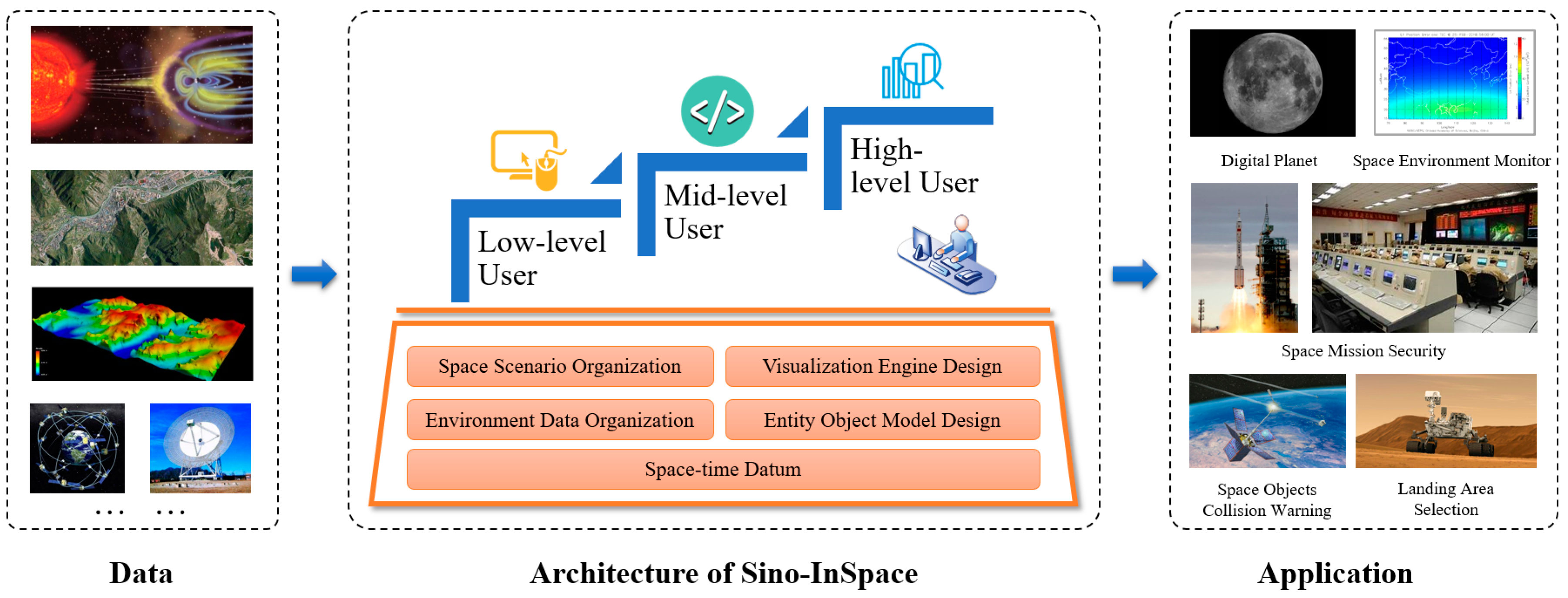
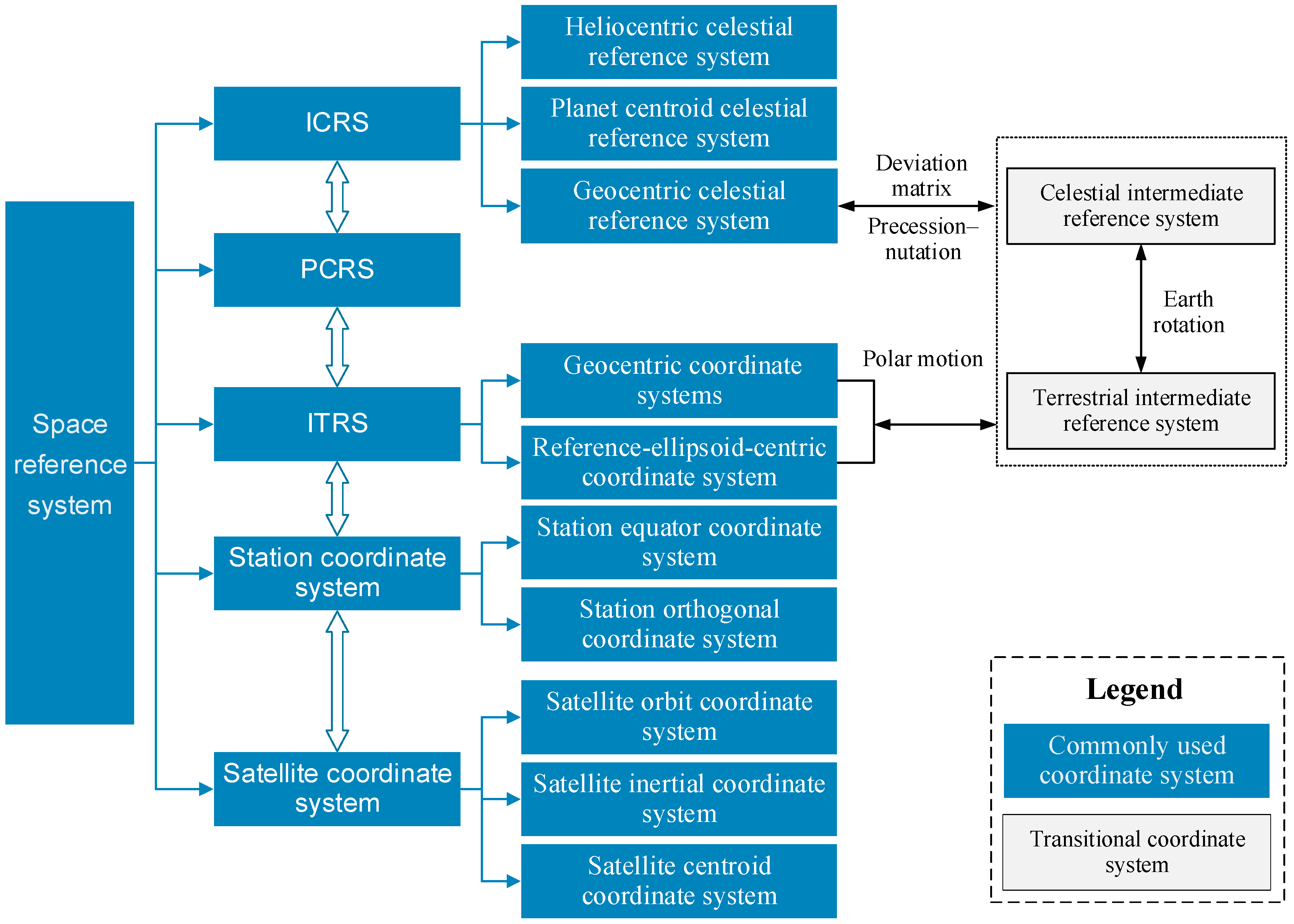
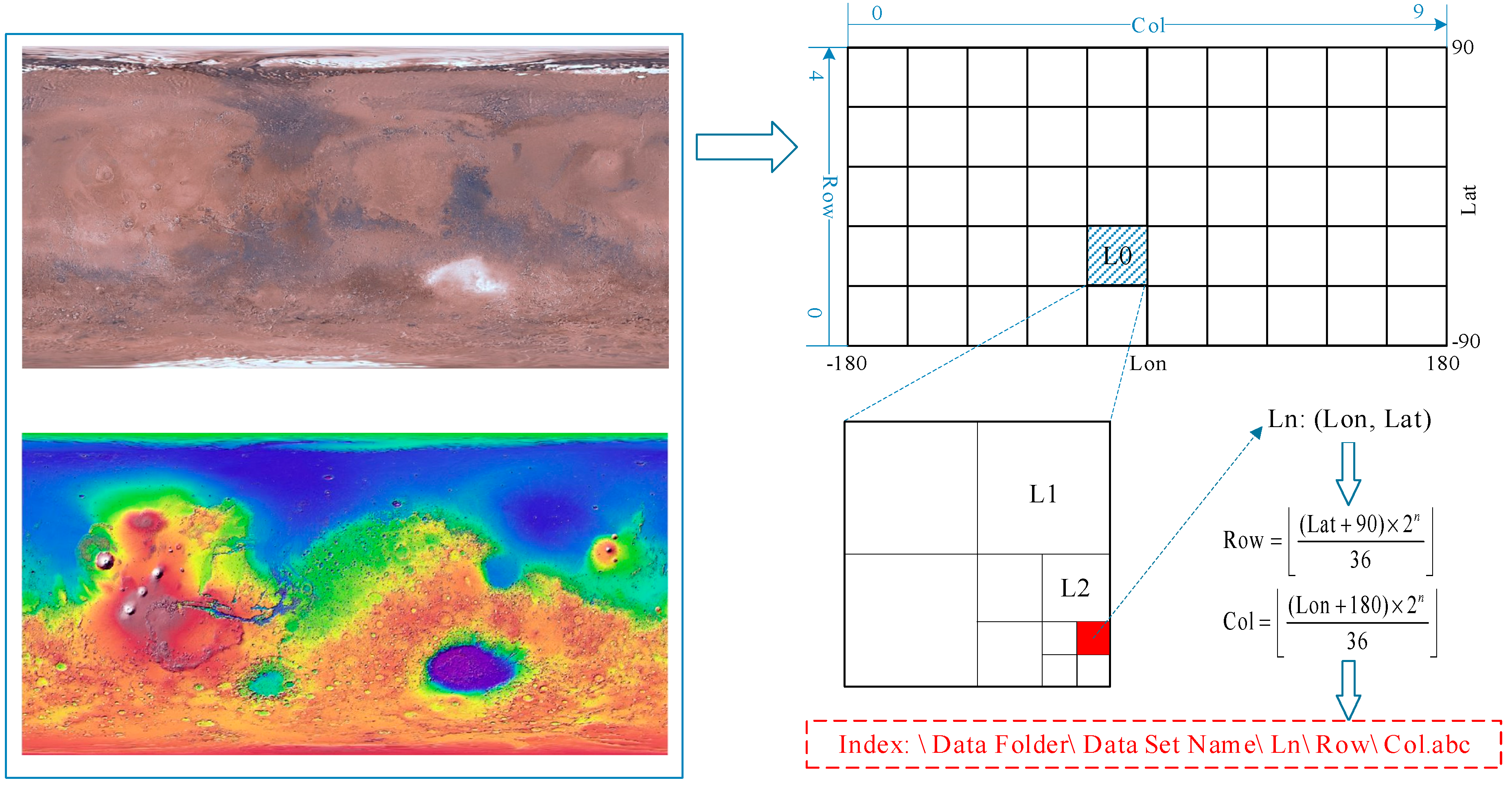
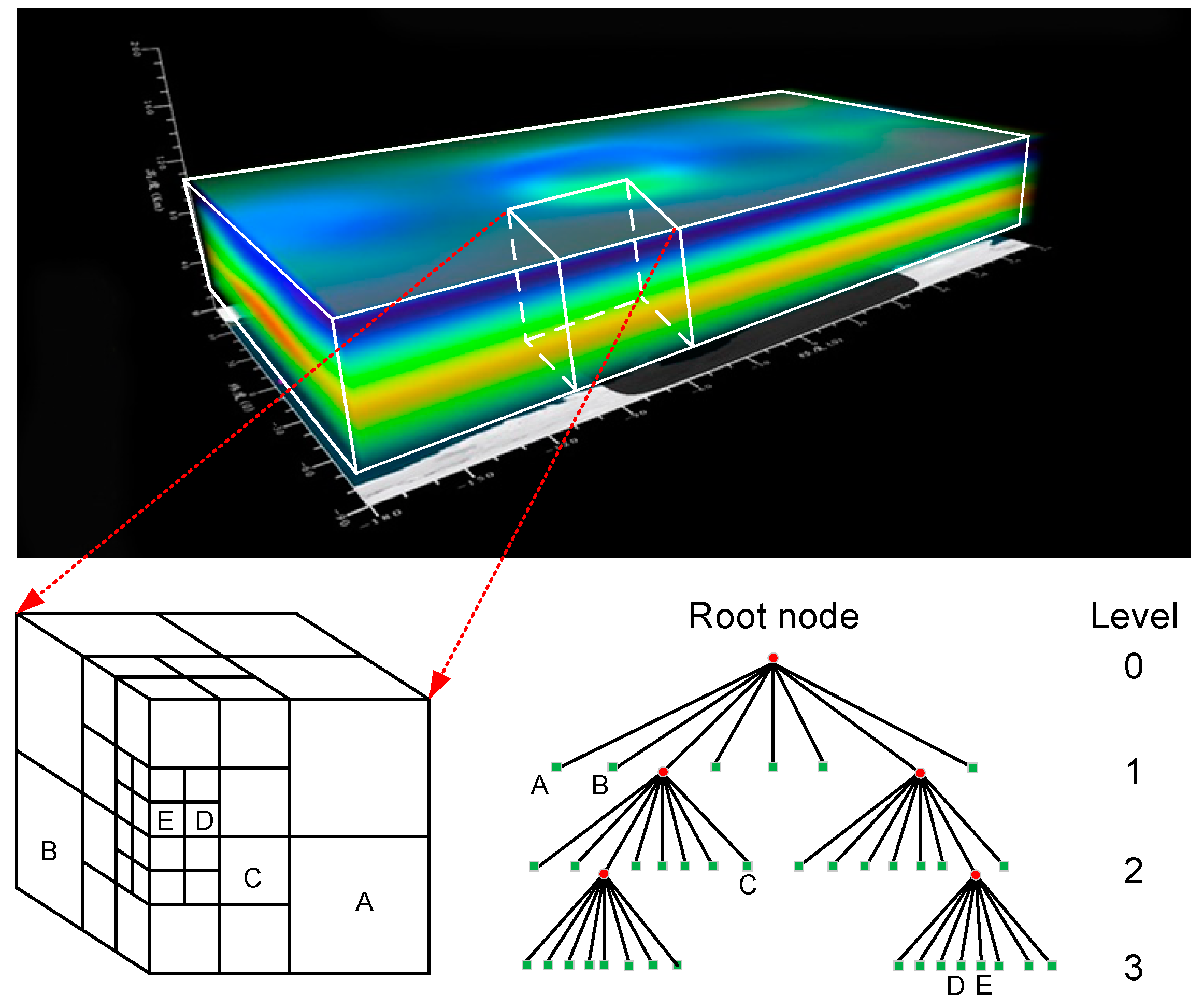
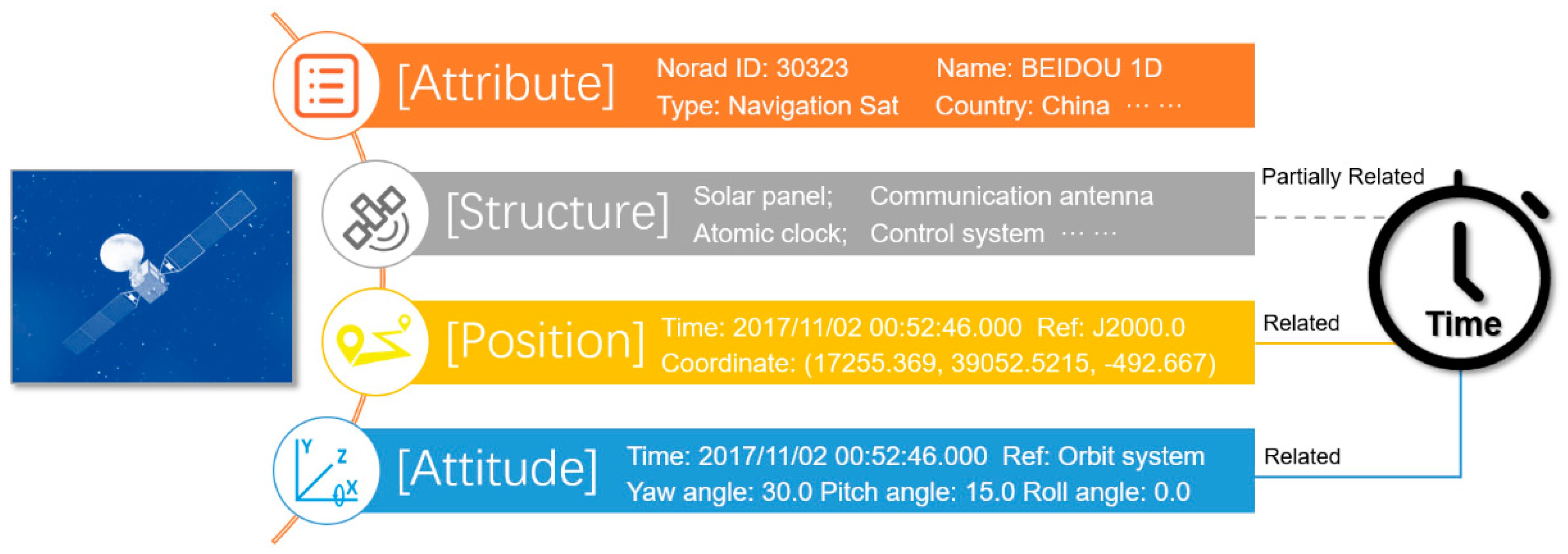
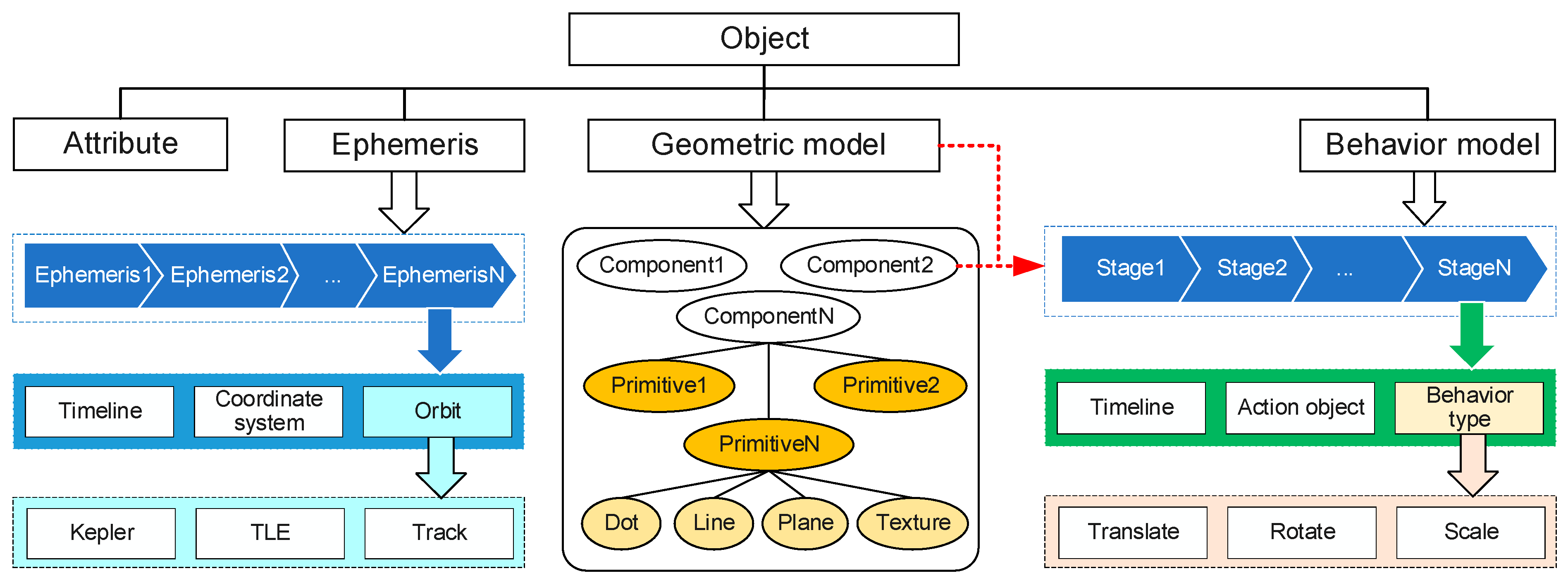
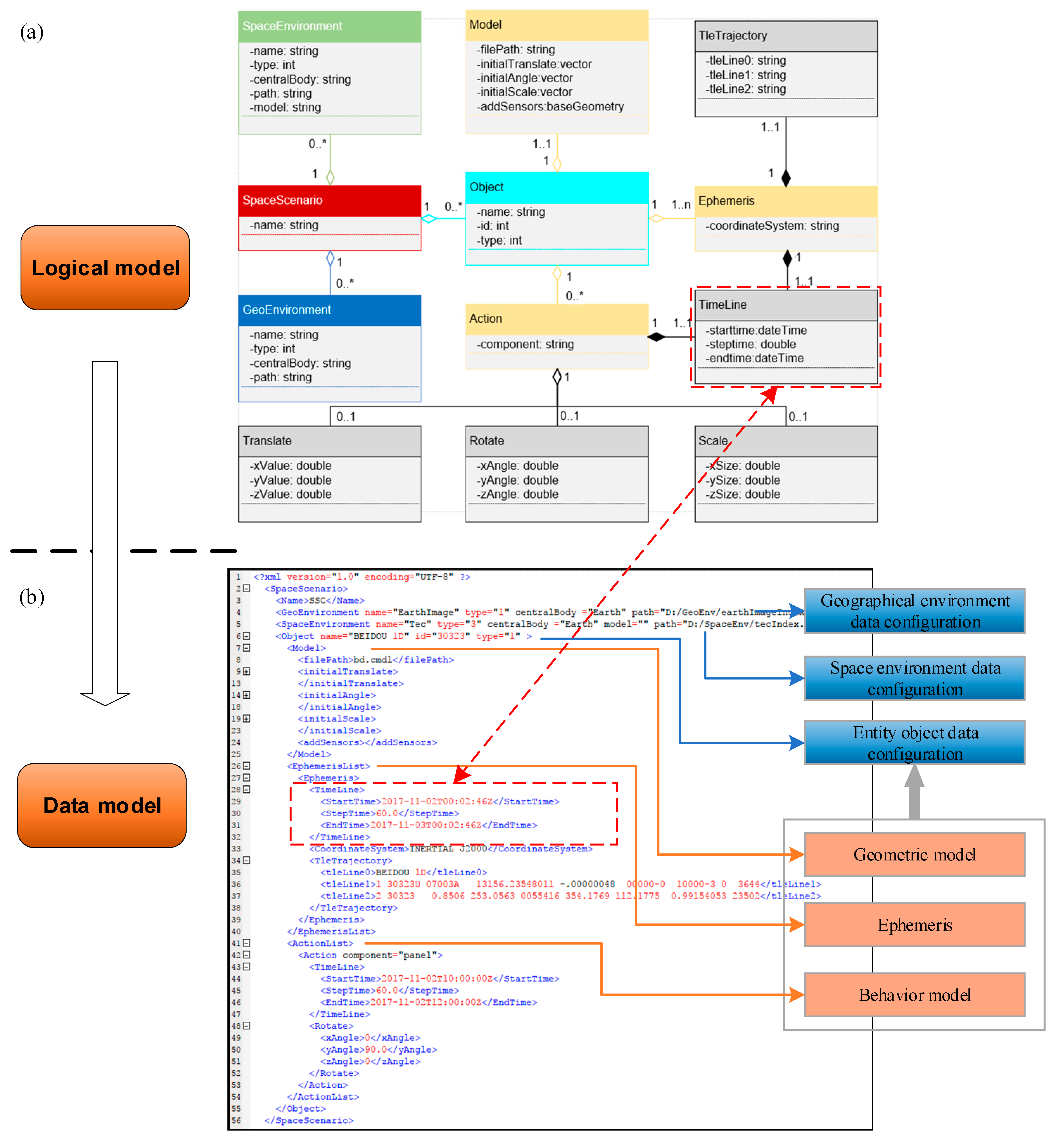


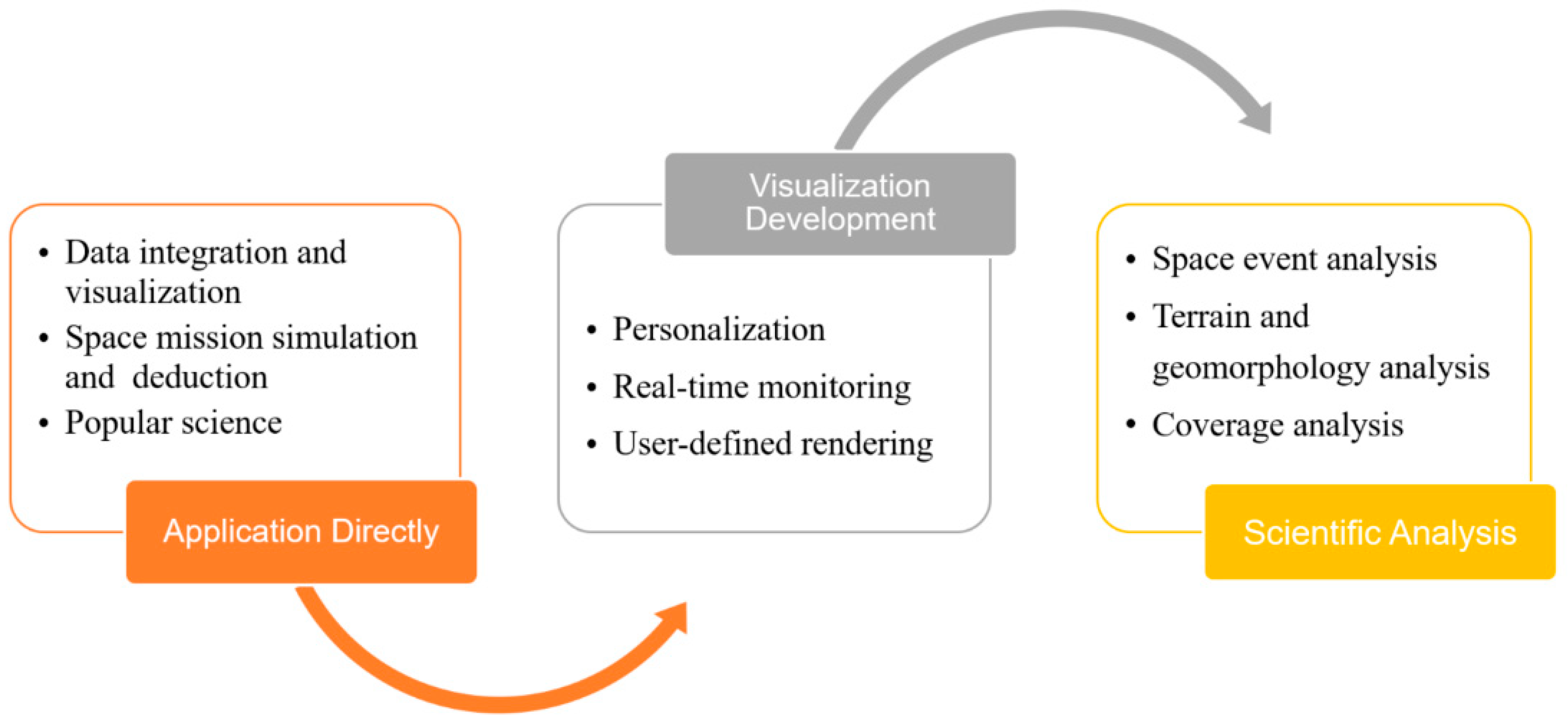

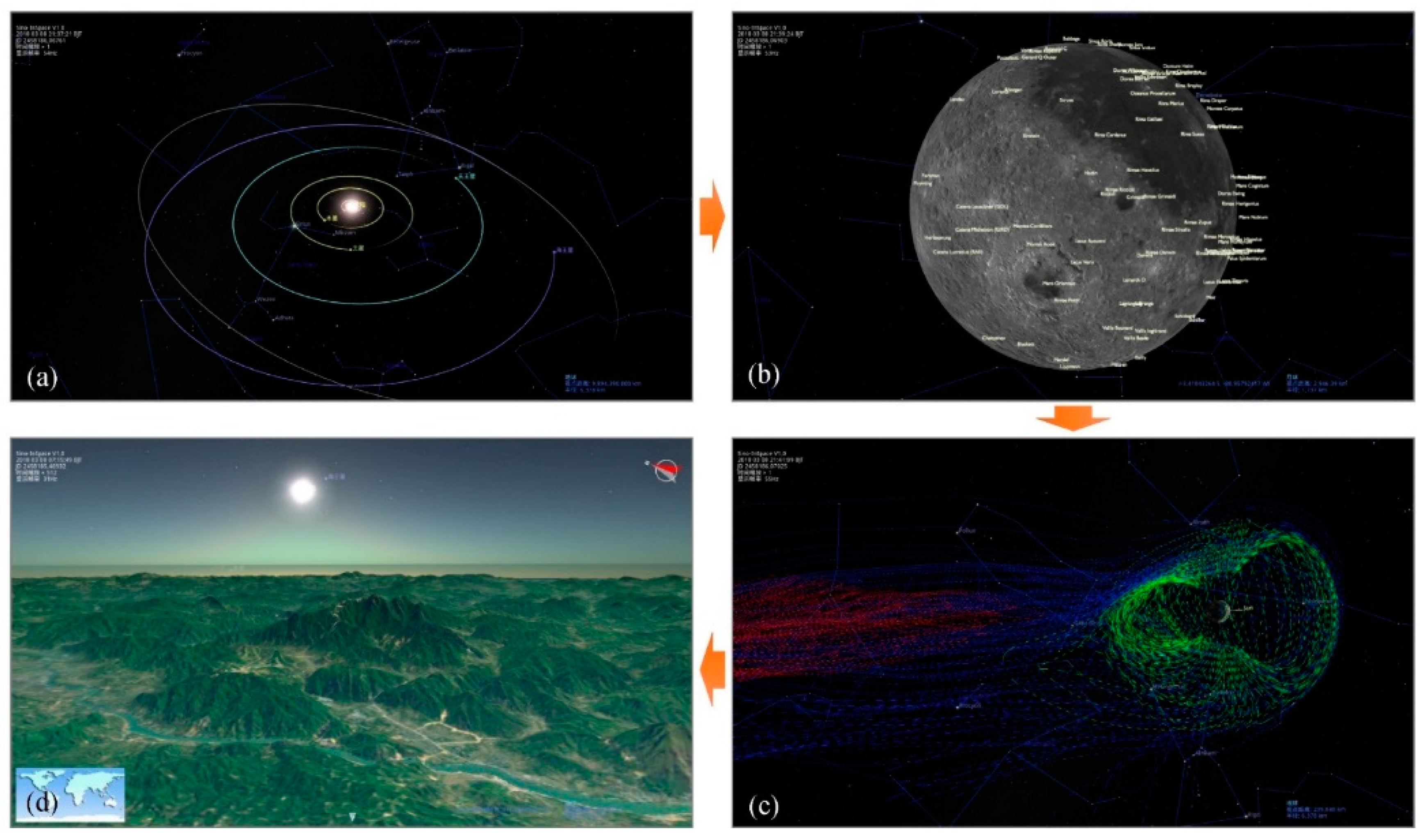
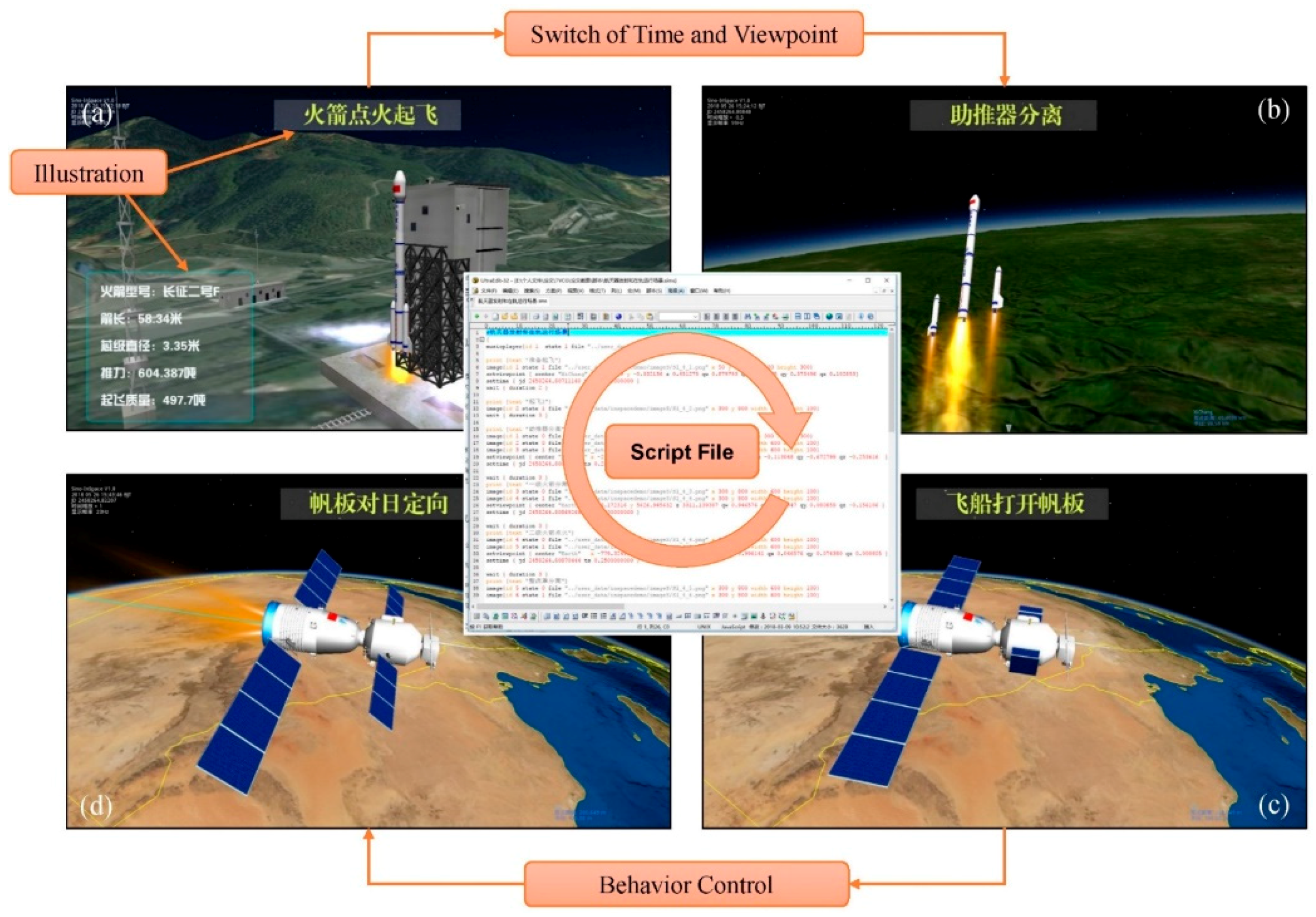
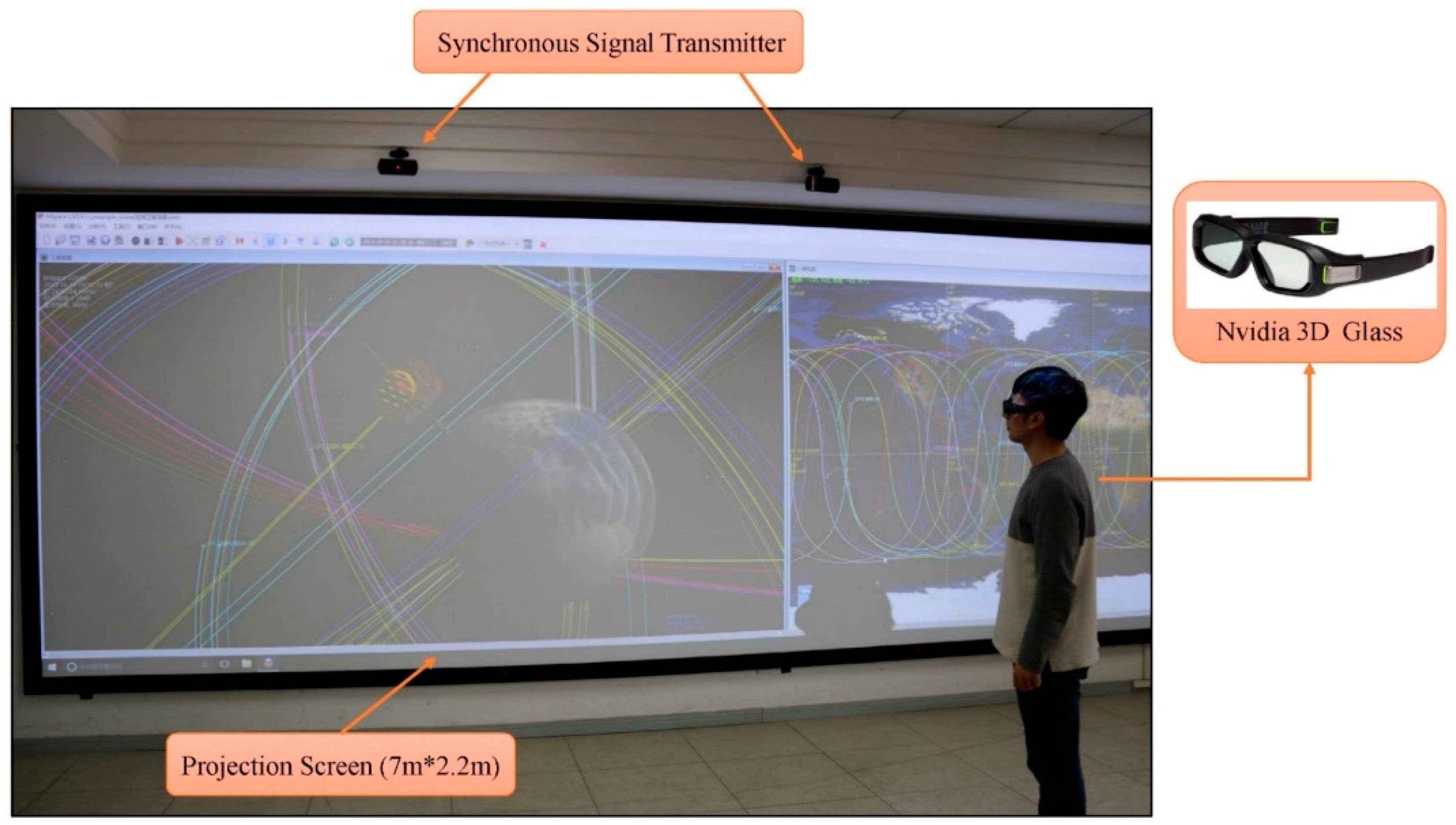
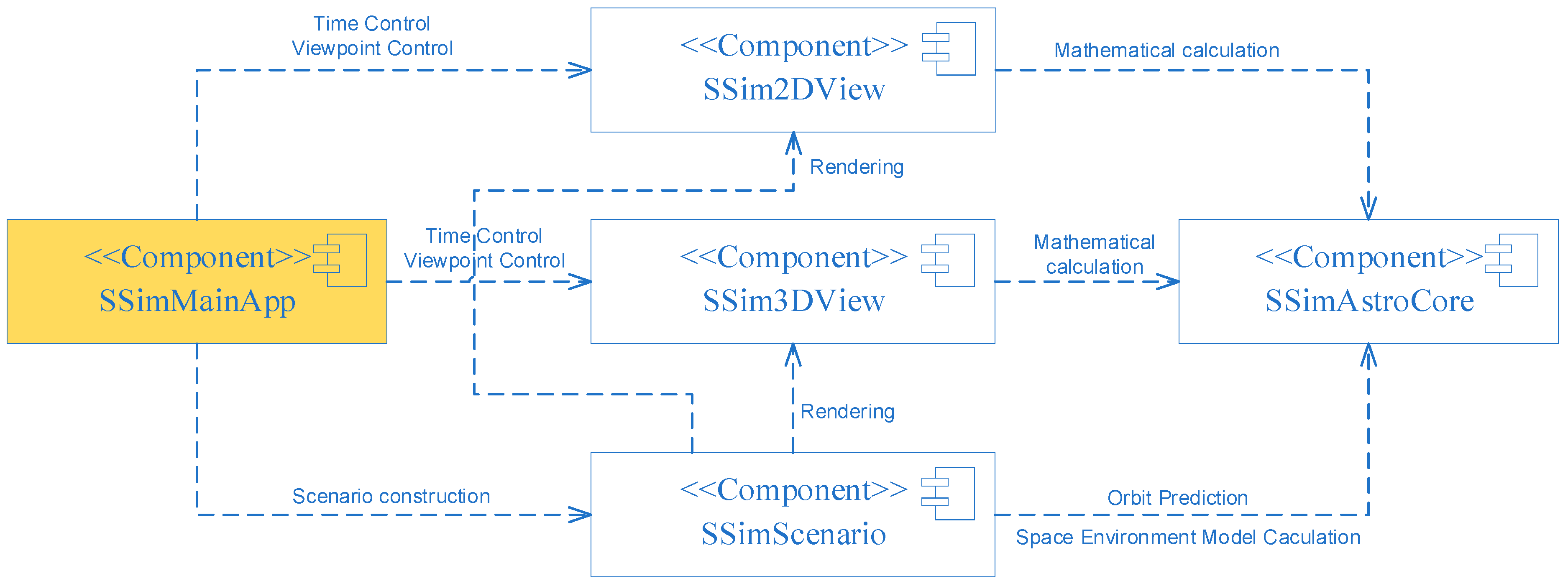
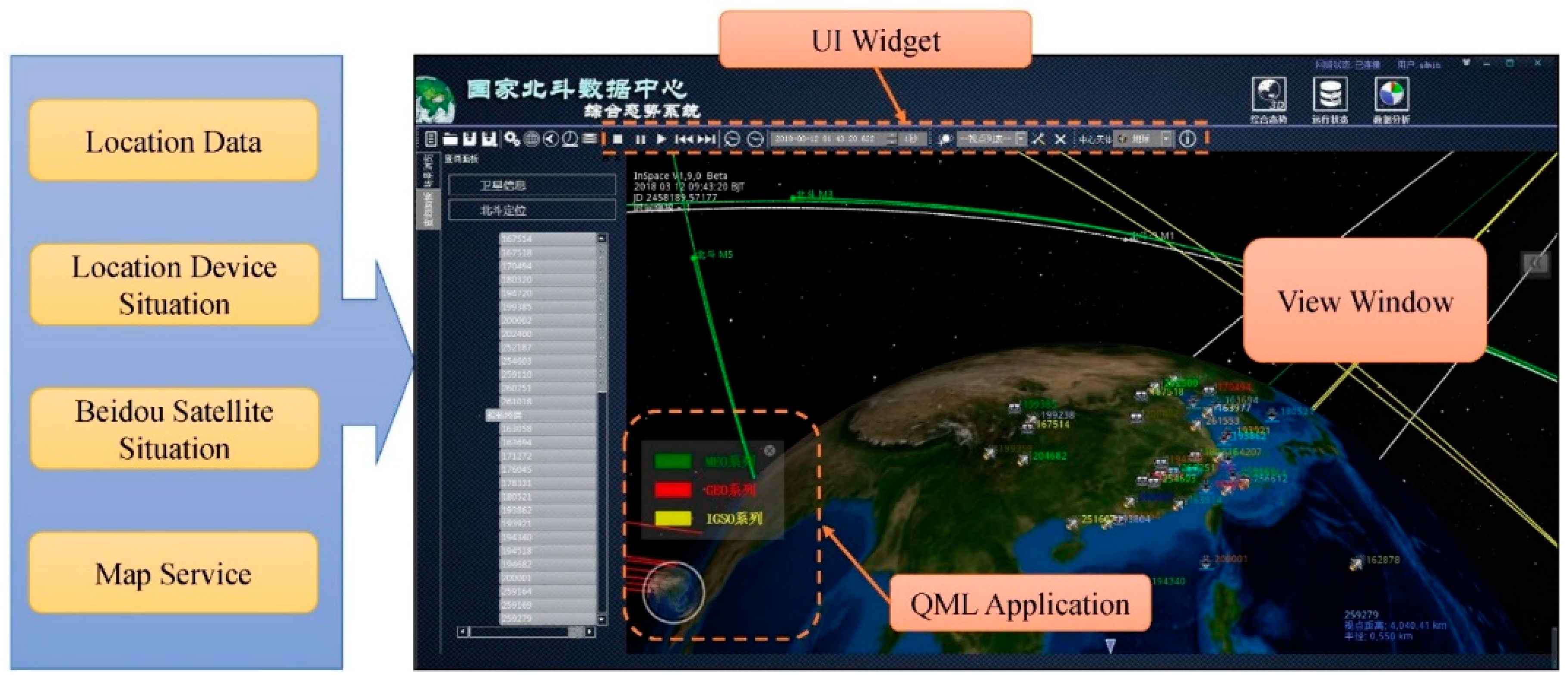
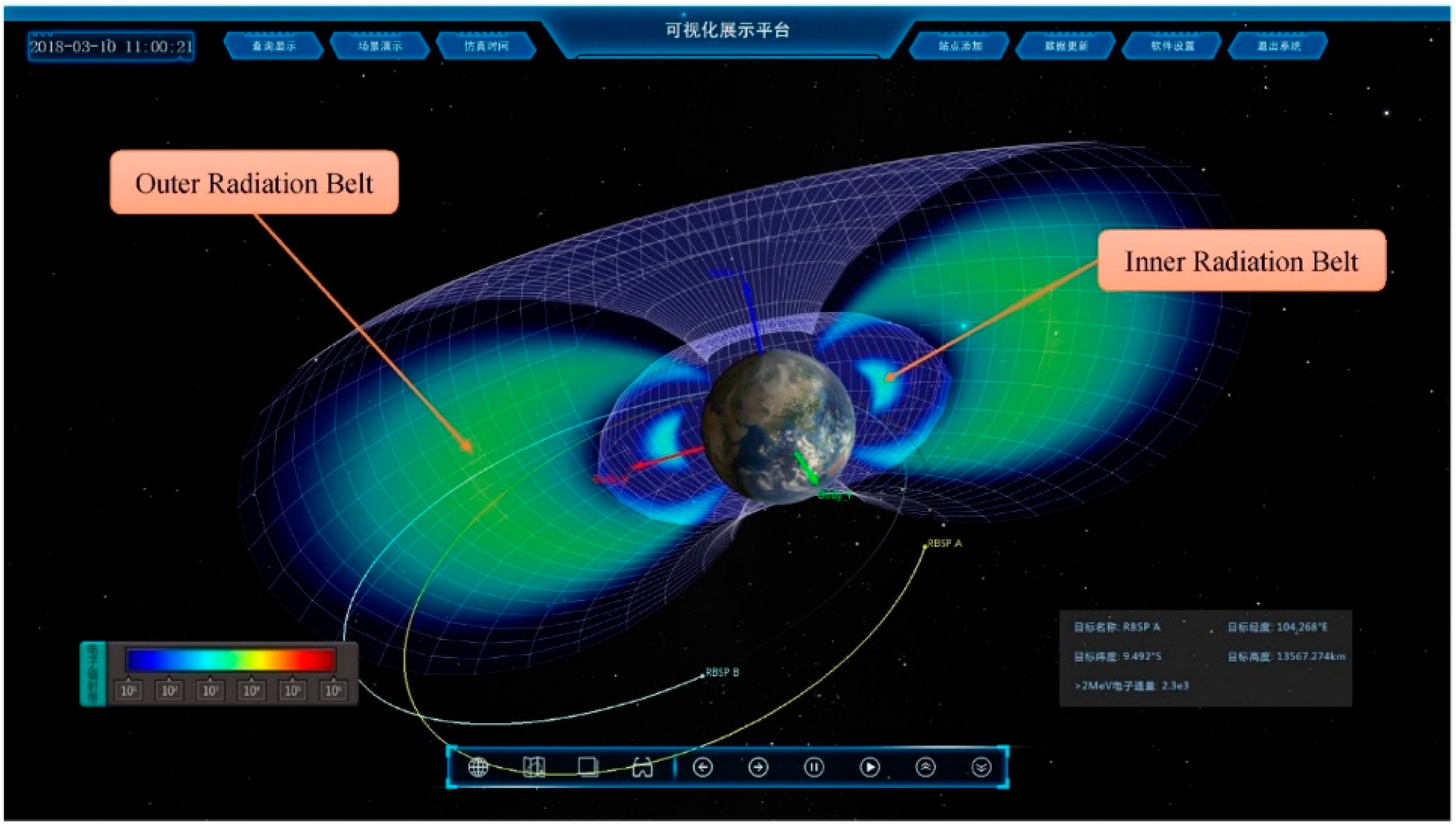
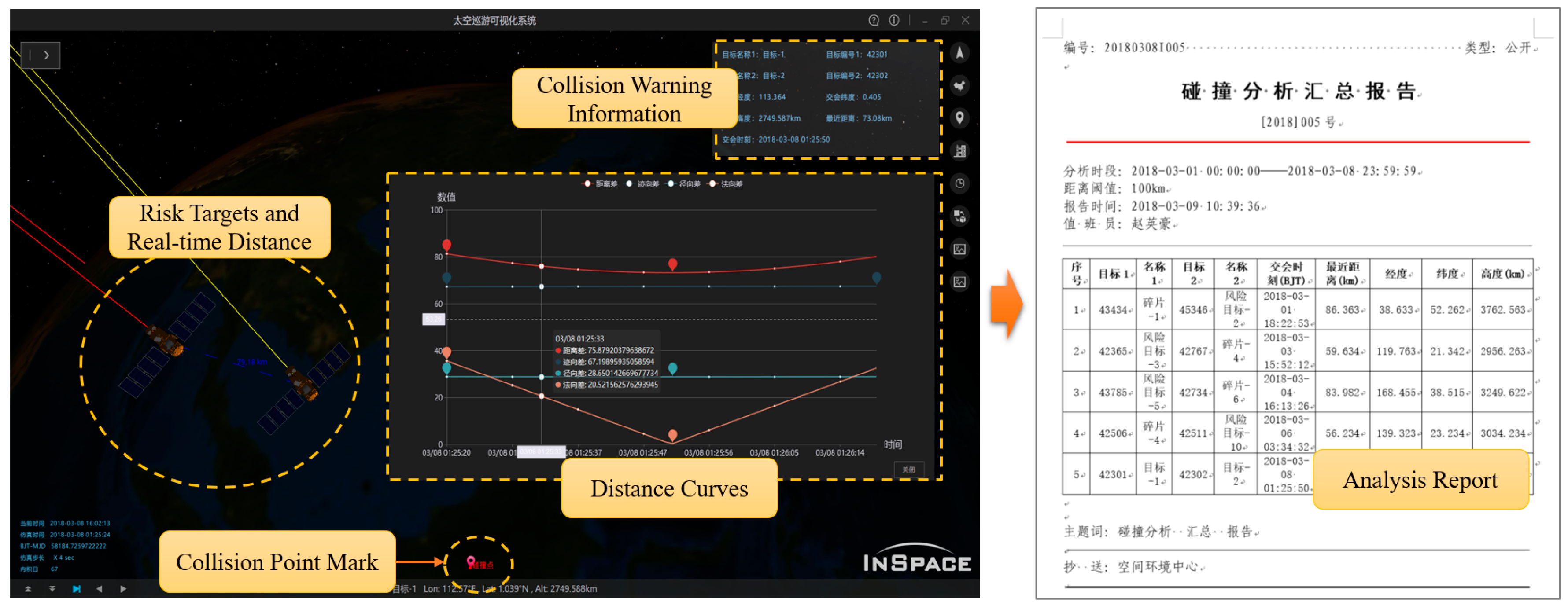
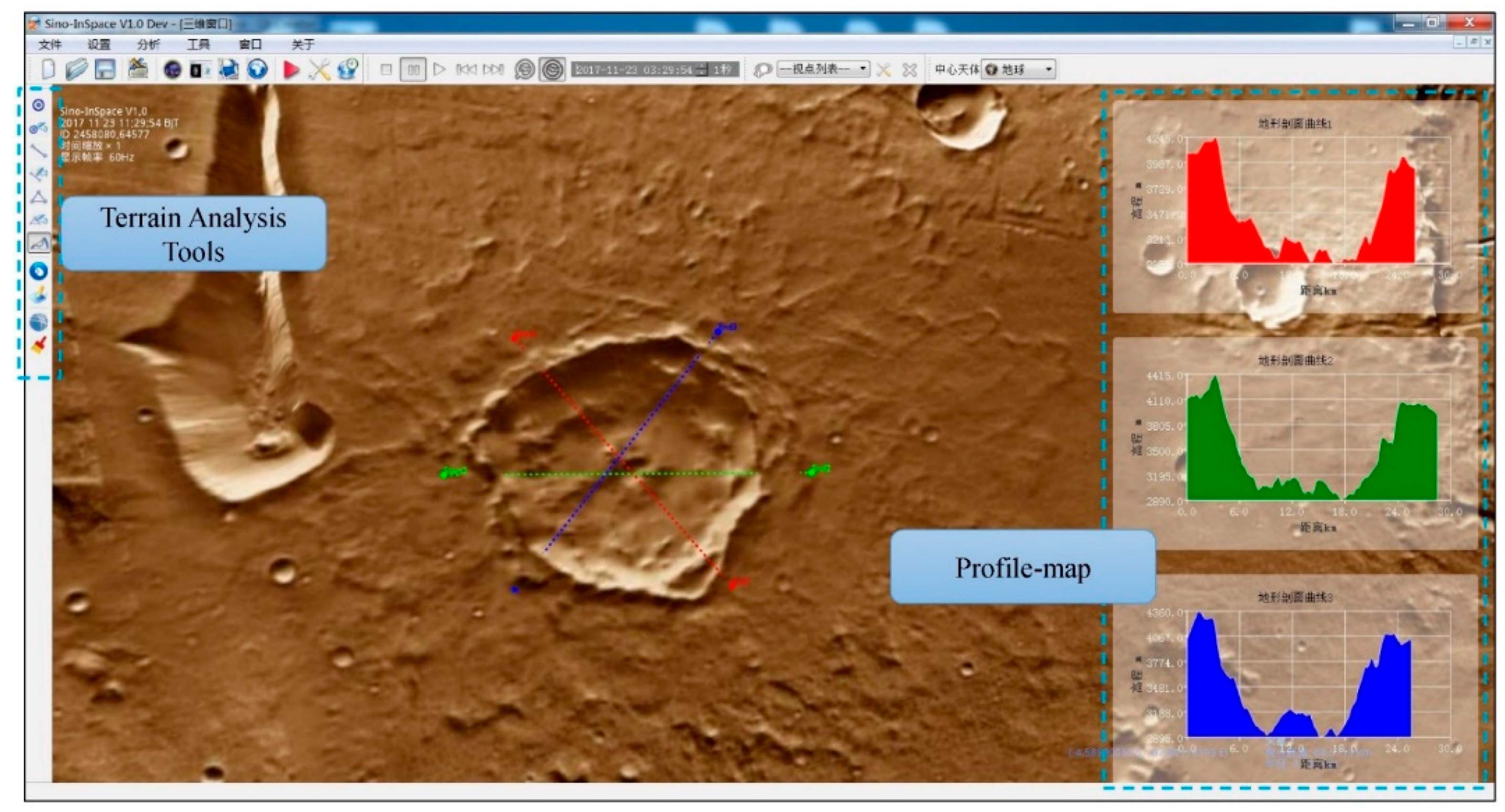
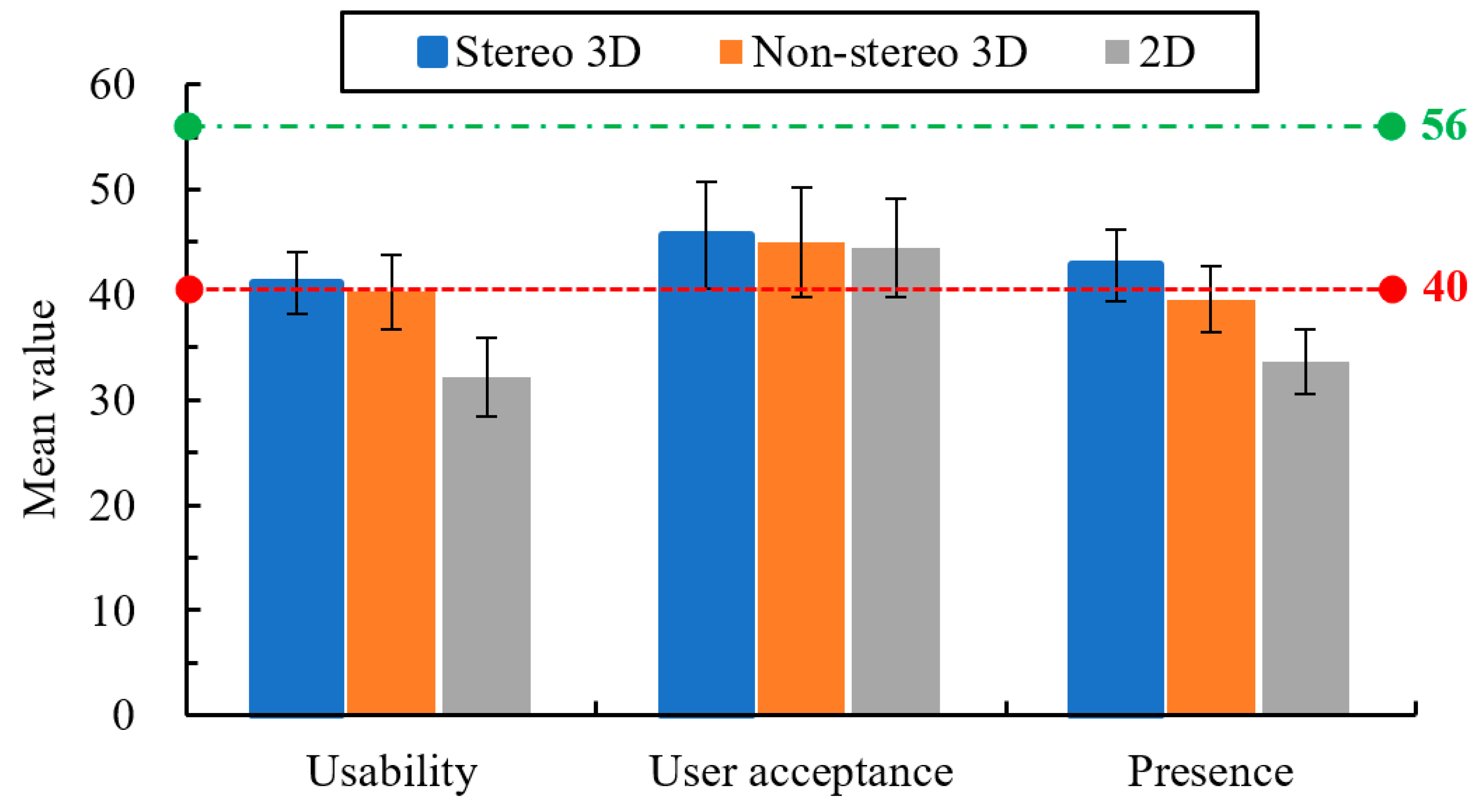
| Data Type | Content | |
|---|---|---|
| Environment element | Basic geographic environment | Remote sensing images on the surface of the planet, digital elevation model (DEM), and vector and feature data. |
| Physical space environment/weather | The position, distribution, temperature and intensity information of physical space environment such as middle and upper atmosphere, geomagnetic field, ionosphere, radiant zone, and so on. The track and size information of space debris. | |
| Entity object element | Background star | Astronomical catalogues of stars containing accurate position, proper motion, level, and color. |
| Planet in the solar system | The size, shape, texture, rotation speed, etc. of planets. Astronomical ephemerides used to calculate the position and velocity of planets. | |
| Spacecraft | Orbit elements, trajectories, attitudes, 3D models, and attributes of artificial satellites and spacecraft. | |
| Ground facility | The location, model, capability, and attribute data of all kinds of ground facilities such as optical telescopes, radar, launching and measurement, and control stations. | |
| Command Identification | Command Meaning | Parameter Identification | Parameter Meaning |
|---|---|---|---|
| setviewpoint | Setting the position and perspective of the observation (data can be obtained from the platform). | center | Central target name. |
| x, y, z | Position of viewpoint in the center body coordinate system | ||
| qw, qx, qy, qz | Attitude of sight in the center body coordinate system represented by the quaternion. | ||
| settime | Setting the time and step of the simulation. | jd | Julian day. |
| ts | Time step. The positive number represents the forward simulation, the negative number represents the backward simulation, and 0 represents the pause. The unit is second. | ||
| wait | The script continues to execute after waiting for a certain length of time. | duration | The length of the script to run pause. The unit is second. |
| Printing the message on the screen. | text | Text hint on the screen. | |
| image | Illustration | id | Picture identification |
| state | 0—hide, 1—show. | ||
| file | File path. | ||
| x, y | The pixel position of the image on the screen. | ||
| width, height | The width and height of the image. |
| Measure | Stereo 3D | Nonstereo 3D | 2D | |||
|---|---|---|---|---|---|---|
| W | p | W | p | W | p | |
| Usability | 0.983 | 0.984 | 0.958 | 0.657 | 0.957 | 0.648 |
| User acceptance | 0.989 | 0.999 | 0.984 | 0.989 | 0.984 | 0.991 |
| Presence | 0.969 | 0.837 | 0.969 | 0.836 | 0.984 | 0.973 |
| Measure | Stereo 3D | Nonstereo 3D | 2D | |||||||||
|---|---|---|---|---|---|---|---|---|---|---|---|---|
| M | SD | T | p | M | SD | T | p | M | SD | T | p | |
| Usability | 41.13 | 2.90 | 1.51 | 0.92 | 40.27 | 3.54 | 0.29 | 0.61 | 32.20 | 3.75 | −8.07 | 0.00 |
| User acceptance | 45.67 | 5.08 | −7.88 | 0.00 | 45.00 | 5.18 | −8.22 | 0.00 | 44.47 | 4.66 | −9.59 | 0.00 |
| Presence | 42.80 | 3.40 | 3.18 | 1.00 | 39.53 | 3.16 | −0.57 | 0.29 | 33.60 | 3.09 | −8.02 | 0.00 |
| Measure | Homogeneity Test | ANOVA | ||
|---|---|---|---|---|
| L | p | F | p | |
| Usability | 0.306 | 0.738 | 31.265 | 0.000 |
| User acceptance | 0.041 | 0.960 | 0.219 | 0.804 |
| Presence | 0.042 | 0.959 | 31.451 | 0.000 |
© 2018 by the authors. Licensee MDPI, Basel, Switzerland. This article is an open access article distributed under the terms and conditions of the Creative Commons Attribution (CC BY) license (http://creativecommons.org/licenses/by/4.0/).
Share and Cite
Lyu, L.; Xu, Q.; Lan, C.; Shi, Q.; Lu, W.; Zhou, Y.; Zhao, Y. Sino-InSpace: A Digital Simulation Platform for Virtual Space Environments. ISPRS Int. J. Geo-Inf. 2018, 7, 373. https://doi.org/10.3390/ijgi7090373
Lyu L, Xu Q, Lan C, Shi Q, Lu W, Zhou Y, Zhao Y. Sino-InSpace: A Digital Simulation Platform for Virtual Space Environments. ISPRS International Journal of Geo-Information. 2018; 7(9):373. https://doi.org/10.3390/ijgi7090373
Chicago/Turabian StyleLyu, Liang, Qing Xu, Chaozhen Lan, Qunshan Shi, Wanjie Lu, Yang Zhou, and Yinghao Zhao. 2018. "Sino-InSpace: A Digital Simulation Platform for Virtual Space Environments" ISPRS International Journal of Geo-Information 7, no. 9: 373. https://doi.org/10.3390/ijgi7090373
APA StyleLyu, L., Xu, Q., Lan, C., Shi, Q., Lu, W., Zhou, Y., & Zhao, Y. (2018). Sino-InSpace: A Digital Simulation Platform for Virtual Space Environments. ISPRS International Journal of Geo-Information, 7(9), 373. https://doi.org/10.3390/ijgi7090373





